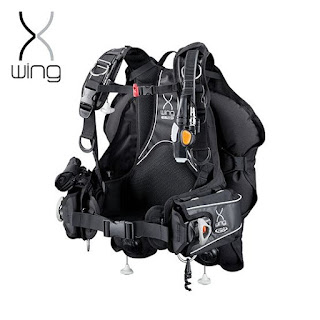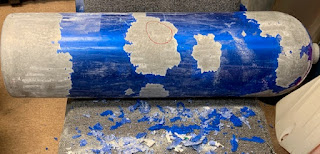Your jacket, ma'am...or do you prefer wings?
Nate Davis, age 10, performing a buoyancy check.
Nate is using a Dive Rite TransPac harness and Rec Wings
Image: Rose Bennett
Fred Stratton
Instructor and Repair Technician
Thank you for the questions we've received since we posted back-to-back articles on buoyancy compensators (BCs) in February and March 2018. Let's look at the myths and misconceptions that triggered the comments and questions and educate ourselves with facts.
"I was told that back inflation BCs force your face forward at the surface, making them dangerous. Is this true?"
This is like saying that giving children piggy back rides is dangerous because you'll fall backwards. What happens when they climb on? You adjust your body position to maintain your balance, right?
Properly Inflate your BC at the Surface
Scubapro XTek back inflation BC
Image: Scubapro |
Many divers overinflate their BC at the surface. If some air is good, lots of air is better, right? Nope! Too much air in your (jacket) BC restricts your breathing and moves your center of gravity unnecessarily high.
Add just enough air in your BC at the surface to ensure a clear airway and to maintain contact with your buddies and boat crew (or shore support).
If the surface is choppy, use your snorkel or regulator to maintain a dry airway. If you surface away from your boat, deploy your surface marker buoy to alert the crew of your location.
Get the Lead Out
Having just the right amount of lead vastly improves your comfort and has a HUGE impact on developing an efficient streamlined (horizontal) swimming technique. Sure, you can overweight yourself and compensate with your BC, but BoN divers are better than that!
Have you wondered how your first scuba instructor determined how much weight you needed before your first confined water session? Well, it's simple math and judgment. We start off with 5% to 10% of a person's bodyweight and adjust from there. I weigh 160 pounds. I use 10 pounds in fresh water with a 5mm wetsuit and an aluminum 80 cylinder. I use 12 pounds in salt water. I use 4 pounds when diving steel cylinders in my rebreather in fresh water using a crushed neoprene drysuit.
| Sidemount diver adjusting kit before descending Image: Rose Bennett |
| Properly weighted rebreather divers in Dive Rite TransPac harness and CCR XT wings
Image: Rose Bennett
|
Weight belts are going the way of J valves and double-hose regulators. Both jacket and wing-style BCs are available with integrated weight pockets and non-dumpable trim pockets. Jacket BC trim pockets are usually astride the BC's cylinder strap. Typical capacity is up to five pounds. (I recommend using soft weights; they conform to your body.)
The integrated weight pockets normally sit near one's hips, facilitating removal should that become necessary at the surface to remain positively buoyant or to aid a fellow diver. Say you use 16 pounds. Start with four pounds in your two weight integrated pockets and four pounds each in your rear-mounted trim pockets. Jump in the pool and adjust as required.
 |
| Active BoN Dive Crew members honing their skills and having fun. Image: Bubbles or Not Diving |
Wing style BC: Some divers use steel or aluminum backplates, sandwiching their wings between their cylinder(s) or rebreather and the backplate. Many divers can get rid of their weight belts and utilize trim weight pockets when using a backplate. Another advantage is that the backplate evenly distributes weight along the diver's torso. A disadvantage is that it can not be jettisoned in an emergency (although I've never had to dump weight in 31 years of diving).
By design a wing and harness system is infinitely adjustable to each diver's physique, experience, exposure suit, and environment as the diver can place weight exactly where she needs it. This precision is unachievable with most jackets.
By design a wing and harness system is infinitely adjustable to each diver's physique, experience, exposure suit, and environment as the diver can place weight exactly where she needs it. This precision is unachievable with most jackets.
"I like diving on reefs and the exterior of wrecks so I need a jacket BC."
We all like comfort. Diving in a horizontal position is comfortable. Back inflation BCs almost automatically put you in a horizontal position because you are suspended under the air bladder which runs the length of your torso, from your shoulders to your tush.
Jacket BCs tend to put you in a head-up, diagonal position. You use more energy to move through the water, increasing your gas consumption to oxygenate your leg muscles, reducing your bottom time. Does this sound comfortable to you?! All divers - recreational, technical, commercial, scientific - strive to be calm, comfortable and safe in the water. The BC that helps you achieve that state is the right BC for you.
"Back-inflation BCs are for cave and tech divers, aren't they?" (Jackets are for rec, wings are for tec.)
FALSE! Why are back inflation BCs associated with technical diving? Simply because technical divers ofter are the first to try new equipment and techniques. As Nitrox once was deemed beyond recreational divers' grasp to use, back inflation systems became associated with technical diving.
"You should start out in a jacket BC then try back-inflation BCs after you gain experience."
 |
| Newly certified BoN OW and Advanced Open Water divers. 10-year old Nate Davis front and center.Image: Bubbles or Not Diving |
WRONG! Good scuba instructors can teach any student, as young as 10 years old, to dive in a set of wings. Young Nate Davis (photo right) earned his PADI Junior Open Water Scuba Diver certification in August 2018 in a Dive Rite TransPac harness and Rec Wings.
Nate is the best proof that anyone can learn to dive a back inflation system. It starts with good equipment, student motivation, and skill mastery under the mentorship of a good dive professional like Nate's instructor Steven Thomas (far left in pink rash guard).
"Wings are new technology. Jackets are time tested."
WRONG AGAIN! It bears repeating that Watergill unveiled its At-Pac wing-style (back inflation) BC back in 1972. Revolutionary at the time, the At-Pac was the first unit to integrate a backpack, regulator, BC and weights into one unit and came standard with a low-pressure inflator (LPI) hose that tapped into a LP port on the first stage. So back-inflation BCs have been around for nearly 50 years!
TransPac harness and backplate
Image: Dive Rite
|
Dive Rite Rec Wings
Image: Dive Rite
|
Dive Rite marketed the first commercially avail-able backplate in 1984 and its wing-style BC the following year. Fast forward to 1995 when Dive Rite debuted their TransPac harness. It is infinitely adjustable to all body shapes and sizes. Quick releases make donning and doffing easy.
A crotch strap, waist belt and chest strap secure the unit in place, and lumbar padding adds comfort. Heavy denier nylon and beefy fittings make the current version, the TransPac XT, nearly indestructible. (I have a 20-year old TransPac and wings that are still in perfect working order.)
 |
| TUSA X Wing back inflation BC Image: TUSA |
The TUSA Liberator jacket BC is a Scubalab Best Buy for 2018! It features integrated pockets, 4 D-rings, 2 dump valves, 4 adjustment points (shoulder, waist and chest straps) and 2 zippered pockets.
All TUSA BCs are compatible with the Duo Air II alternate regulator/power inflator.
BC Buying Considerations
If you are new to diving and have yet to try a back inflation BC, I encourage you to try before you buy. If you own a jacket and are happy with your buoyancy and trim, rock on diver. If you are in the market for a new BC, consider your options and make a well-informed decision based on facts. Let's dispel some myths about back inflation BCs.
Summary
- Invest time to dial in your weight distribution.
- A wing and harness system facilitates swapping out wings for various diving purposes.
- Back inflation systems put you in horizontal trim, the most comfortable and ecologically aware position.
- Back inflation systems leave the front of the body unencumbered, allowing greater freedom of movement such as photography or search and recovery tasks.
* My gratitude to Lyric Stratton for editing and improving this article. *
Coming in October










If a 10 year old can learn to water ski then scuba diving isn't a problem. Kudos to Nate!
ReplyDeleteExcellent article! The summary cleared up many of my questions as I was reading the article and weighing the advantages/disadvantages of the different types of BC.
ReplyDelete